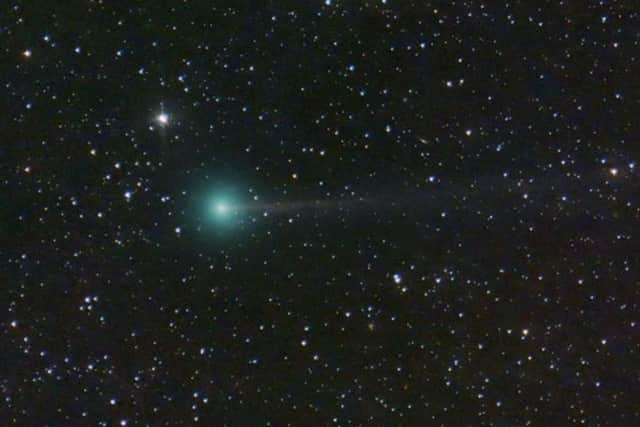A 'once in a life-time event' sees Comet Nishimura pass Earth tomorrow and be visible to the naked eye
and live on Freeview channel 276
Astronomers have revealed a “once-in-a-lifetime” experience, for a “rare and exciting opportunity” to see a comet with the naked eye.
Comet Nishimura was only discovered in August and is passing the Earth tomorrow – just before dawn on Tuesday 12 September.
Advertisement
Hide AdAdvertisement
Hide AdThere is no danger of Nishimura will collide with Earth as astronomers have carefully charted its orbit and speed of travel - which is 240,000 miles per hour.


According to Professor Brad Gibson, director of the E A Milne Centre for Astrophysics at the University of Hull, the comet is already visible to the naked eye and can be seen in the hour after sunset and the hour before dawn by looking east-north-east, towards the crescent moon and Venus.
He said: “The comet takes 500 years to orbit the solar system, Earth takes one year, and the outer planets can take many decades.
“Halley’s Comet, which caused much interest during its last nearby visit to Earth in 1986, takes 76 years to orbit the solar system.
Advertisement
Hide AdAdvertisement
Hide Ad“So, to say this is a once-in-a-lifetime opportunity to see Nishimura isn’t an exaggeration.”
Prof Gibson said: “It can already be seen but it will be 78 million miles from Earth on September 12 and that should be the best chance to see it with the naked eye.
“On average, people have the chance to see such a naked eye comet once a decade – this is a rare and exciting opportunity.”
Astronomy expert Professor Don Pollacco, Department of Physics, University of Warwick said: “Comet Nishimura was discovered only recently but observations indicated it had an orbital period of about 400 years. So this is its first trip near the Sun since the middle ages.
Advertisement
Hide AdAdvertisement
Hide Ad"Over the next few nights it will pass the Earth and we will see the comet at its best. While Hyakutake came between the Earth-Moon, Nishimura will only get 78 million miles from Earth on September 12. While the predictions are that it may just make naked eye visibility but would be better seen with binoculars, with comets you just never know!
“To see it you need to get up early and go outside about 90 minutes before sunrise. Look east and find the constellations of Leo and Cancer which will be rising about 10 degrees above the horizon.
"Leo is easier to see as its “sickle” is composed of bright stars. You need to do this before the 13th September as after that date it will be difficult to see as it moves south (hence easier to see from the southern hemisphere). With binoculars you might just see a small tail (opposite in direction to the Sun).
"The next opportunity to see Comet Nishimura will be about 2423 so you might as well have a go tonight!.”
Advertisement
Hide AdAdvertisement
Hide AdComet C/2023 PI is named after Japanese astrophotographer Hideo Nishimura who recorded it when he was taking long-exposure photographs of the sky with a digital camera on 11 August.
Prof Gibson said Nishimura will pass closest to the sun on 17 September when it will be just 27 million miles away.
He said there is a real chance it may not survive this close fly-by.
Scientists are still trying to estimate Nishimura’s size but Prof Gibson believes it could range from a few hundred metres to potentially a mile or two in diameter.
Advertisement
Hide AdAdvertisement
Hide AdHe said it is thought the comet could be responsible for an annual meteor shower named the Sigma-Hydrids, which takes place in December every year.
The professor said comets are “chunks of ice and rock” left over from the formation of the solar system nearly five billion years ago.
As they pass closer to the sun it heats the comet, liberating an icy gas which gives them their distinctive tail.
He said tiny particles of dust and rock from comets are freed by the sun as a comet passes nearby and each year the Earth passes through this debris, leading to meteor showers.
Advertisement
Hide AdAdvertisement
Hide AdThere is a debate between scientists over whether it was an asteroid or a comet which caused the extinction of dinosaurs 65 million years ago.
He said: “What happened to the dinosaurs is a once-in-a-100-million-year event.
“People have been watching comets since ancient times with their interpretation then spanning everything from being portents of doom to simply being heralds of good news.”
Comment Guidelines
National World encourages reader discussion on our stories. User feedback, insights and back-and-forth exchanges add a rich layer of context to reporting. Please review our Community Guidelines before commenting.
